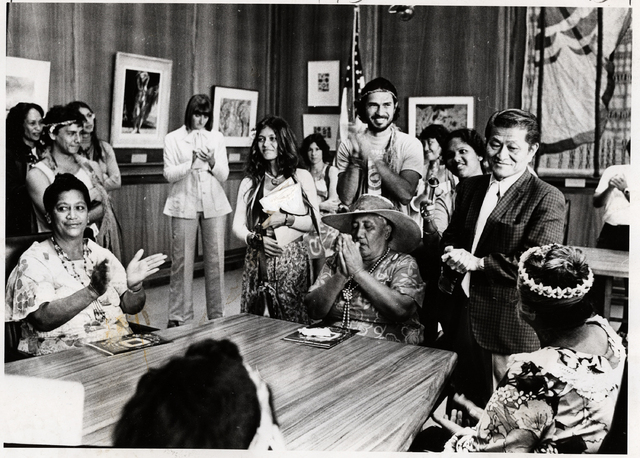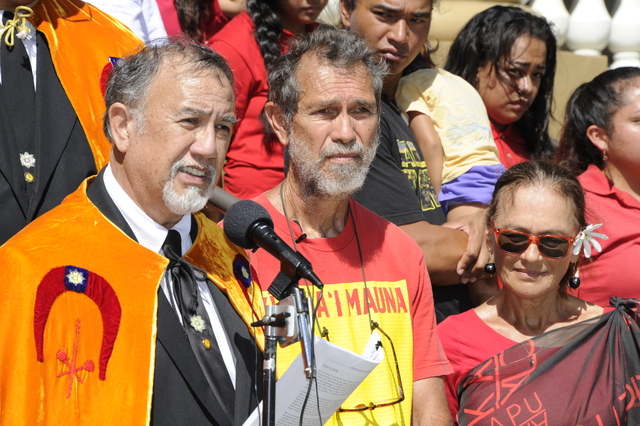Kahoolawe protest group helped spur its cleanup

Star-Advertiser / 1976
A group of Molokai and Maui activists, including Walter Ritte Jr., standing middle, meets with Lt. Gov. Nelson Doi, right. Doi said he supported the return of Kahoolawe to the state and promised to help the group gain access to the island.

I could feel a tingling in my toes. The island was calling out for help.”
Walter Ritte Jr. (pictured middle)
Hawaiian activist


Walter Ritte Jr. can still recall when he first felt Kahoolawe’s strong emotional tug.
It was January 1976 and he and Dr. Emmett Aluli, both Hawaiian activists, had just been arrested on the island.
“I could feel a tingling in my toes,” Ritte said. “The island was saying it was dying. The island was calling out for help.”
The Navy, which had used the barren isle for target practice since World War II, removed the two by helicopter, but Ritte returned repeatedly and was arrested several more times.
This month Protect Kaho‘olawe Ohana activists and their supporters are marking the 40th anniversary of the group’s first protests, which they regard as a political struggle tied to the 1970s’ Hawaiian Renaissance — a revival of long-suppressed and neglected traditional cultural identity expressed in everything from music, language and hula to Hawaiian voyaging.
“I think the key thing is the revitalization of aloha aina — recognizing the island’s sacred nature, and the sacred nature and kinship between Native Hawaiian people and the land and the gods,” said Ty Kawika Tengan, chairman of the University of Hawaii’s Department of Ethnic Studies.
Don't miss out on what's happening!
Stay in touch with breaking news, as it happens, conveniently in your email inbox. It's FREE!
Ritte and Aluli were leaders of the PKO, which filed a federal lawsuit seeking a halt to military training on the 45-square-mile island. In 1977 the court allowed training to continue but directed the Navy to prepare an environmental impact statement and undertake an inventory of Kahoolawe’s historic sites.
The protests continued, and activists George Helm and Kimo Mitchell disappeared while crossing to Kahoolawe from Maui in 1977. A memorial in their honor stands today at the island’s Hakioawa Bay.
Through their court fight, the PKO activists were granted access to the island to practice traditional religious beliefs. In the early 1980s their efforts led to the island, with 544 archaeological and historic sites, being listed on the National Register of Historic Places.
In the early 1990s live-fire training ended, and the Navy turned over control of Kahoolawe to the state.
When an ordnance cleanup effort began in 1994, there was an understanding that the Navy would clear 100 percent of the surface and 30 percent of the island to a depth of 4 feet, according to the state Kaho‘olawe Island Reserve Commission, which has authority over the island.
Ten years later 75 percent of the surface ordnance had been removed and 9 percent cleared to a depth of 4 feet. That added up to 10 million pounds of ordnance.
But a substantial amount remains and the cleanup has since stalled.
“The push for more UXO (unexploded ordnance) cleanup will have to come from our congressional delegation directing the Navy to continue the work and to provide the funding,” commission Director Michael Nahoopii said last week. “The federal government has a responsibility to help the state restore the island as a unique and important natural habitat.”
However, Nahoopii acknowledges the political circumstances are different from those of the mid-1990s, when U.S. Sen. Daniel Inouye was chairman of the defense appropriations subcommittee and no wars were underway.
These days KIRC officials and volunteers are focused on restoring vegetation to cleared areas.
The commission has $1 million in state funds for fiscal 2016-17, in addition to grants and donations. Also, the state has provided KIRC with $2.5 million to build a solar panel grid on Kahoolawe.
KIRC officials have asked state lawmakers to set aside a portion of the state’s conveyance tax to restore natural habitat and maintain the island as a national cultural treasure. But the requests were met with resistance at the state Legislature, Nahoopii said.
The Protect Kaho‘olawe Ohana has received $129,100 from the state Office of Hawaiian Affairs for a fund that aims to provide training for cultural practitioners in 2016-17.
Nahoopii said the commission is prohibited from generating revenue through commercial activities on Kahoolawe.
Under state law the future plan for Kahoolawe calls for it to be among the first lands transferred to a sovereign Native Hawaiian entity recognized by the state and federal governments.
Aluli, the Protect Kaho‘olawe Ohana leader, said the successful movement to halt the bombing of Kahoolawe has had a rippling effect, spreading the concept of protecting and caring for the land. He said he’s optimistic about the future of Kahoolawe.
“As the technology improves and more Hawaii persons are trained in ordnance removal, the cost might not be as prohibitive,” he said.
In retrospect, occupying the island was worth the risk, said Ritte, Aluli’s co-leader.
He recalled that he and fellow Molokai resident Richard Sawyer, both experienced hunters, spent more than a month on the island, living off stashes of water, coconuts, wild goat meat and C rations left by Navy search teams that had been unsuccessful in their efforts to find the pair.
“We were actually following them around,” Ritte said.
The two also walked on goat trails because they thought the paths were generally clear of ordnance and the goat traffic would hide their footsteps.
Ritte said he and the other activists were young and idealistic, and it seemed to them there was no reason why they shouldn’t prevail in their efforts to stop the bombing and shelling.
“We believed what we were doing was right and what they were doing was wrong,” he said.
16 responses to “Kahoolawe protest group helped spur its cleanup”
Leave a Reply
You must be logged in to post a comment.





We miss you and your beautiful music. Keep Hawaiian lands in Hawaiian hands Aloha Brother until we meet again!
I was referring to George Helm.
Who can volunteers contact to clean the Island? Name and phone?
Do they still have the monthly trips to the island? Camping on the beach and helping with restoration projects? That was a great way to introduce people to Kahoolawe and the cultural significance. You couldn’t help coming away with a feeling of love and understanding of what was going on there. And people these days tend to “donate” money to go on cultural eco-adventures like that too. Just a thought.
What has the Navy done since 2004, ten years after they had cleared 75% of the surface of un-exploded bombs and only 9% of the 4′ depth clearance? The remaining 25% surface and 21% 4′ depth clearances must be complete to to fulfill the Navy’s obligation. What are Schatz and Hirono doing for the further removal of the ordinance? The article is not clear on this point.
As one who spent a fair amount of time on Kahoolawe a bit more than half a century ago when assigned to Navy’s Explosive Ordnance Disposal Unit ONE (West Loch, Pearl) I would surmise the effort to sanitize the island will extend until at least the end of this century.
Impact angle, mass and speed of air dropped munitions or projectiles at the moment of impact, and local soil moisture conditions can each influence the depth of penetration of an unexploded item. The amount of time it takes such an item to float back to the surface amid the viscous fluid we like to think of as ‘solid ground’ is a function of forces acting according to Archimedes principal of buoyancy, but it is safe to say it will be a very LONG time before all of it surfaces.
No money left from the feds and the state already accepted the land so it’s the state’s problem now. Should have thought about that before accepting it.
Thinking presents a cognitive challenge which quite a number of the political great and near great in our state lack the wherewithal to meet.
A good location for the homeless people.
Its nothing more than a money/land grab.
The State can put them to work tilling the soil. Grow their own food and live on the land.
Better yet: a good location for our state government reps.
LOL.
Give the homeless shopping carts and magnetic shoes, and have them look for ordnance.
Of the 10 million pounds of ordnance, how much of it was ever recycled and turned in for scrap to recover some of the cost of the clearance? When I did a clearance back there in the 90s, all they did was push everything into a ravine after we detonated the duds. All the kiawe trees were cut down and burned instead of making it into charcoal.
What exactly is this $2M solar farm going to power? Did Hawaiians use PV for traditional practices or is this a loophole to skirt the generation of funds through private activities and sell the power to Maui Electric? A subsurface clearance to four feet is ridiculous. In all my years of clearing ranges around the world, I have yet to see ordnance penetrate only four feet into the ground and stop. Anyone who signs a certificate of clearance for Kahoolawe is either a fool or a very rich fool. The only thing Kahoolawe should be used for is an example to other people, nations, and countries that once land is taken to be used as a bombing and gunnery range, it is lost forever.
How far does it go, if it doesn’t explode?